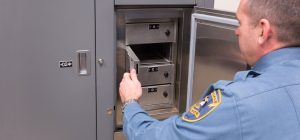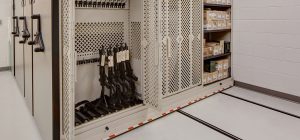Planning for growth when designing evidence storage areas.
If you’re planning to renovate your evidence room or even planning to build a new evidence storage facility, doing your homework now can save headaches later. Here’s how to design your evidence room for future growth:
1. Consider current trends.
Outside forces can have a big impact on crime, and that affects the need for evidence storage. For example, as marijuana legalization becomes a reality in some states, the need for evidence storage for marijuana-related crimes has rapidly diminished in those states. Consider trends in other areas, too. Is your community seeing an uptick or a downturn in thefts, homicides, or other crimes? Can your city, county, or state provide crime projections? This information can help you estimate future evidence storage needs.
2. Use data from past crimes to estimate future needs.
Although there’s no way to know exactly how much evidence will be associated with a particular case, you can learn from past cases. Choose 20 or more cases at random and measure how much space is taken up by the associated evidence. This information, combined with the trend data referenced above, can help you develop estimates for how much space you’ll need for the next 10 or 20 years.
3. Build in extra floor-loading capacity.
If you’re planning new construction, keep in mind that the floors in evidence storage areas might need to bear double or triple the weight in ten or twenty years. Adding floor loading capacity at a later date can be prohibitively expensive, but engineering the building for extra weight right from the start doesn’t add much cost. Talk to your architect about building in extra floor-loading capacity right from the start.
This sheriff’s department in Illinois built a new off-site evidence storage facility with plenty of room to grow. They not only installed high-density storage systems right from the start; they also had rails put into the floor and covered with a thin layer of concrete. When their current systems are full, they will have everything in place to quickly gain more storage capacity.
4. Lay the groundwork for high-density storage, even if you don’t need it now.
According to the IAPE’s Professional Standards, “The use of high-density (mobile) storage shelves is the most effective method to significantly increase storage space.” High-density storage systems consist of shelving that’s mounted on “carriages” that slide along rails in the floor to double storage capacity.
Cost-effective high-density shelving can be added to just about any facility, but it’s even more economical if the rails can be installed when the floor is poured.
Evidence Retention Regulations
Evidence retention rules vary from state to state, so it’s important to thoroughly understand the rules that apply to your department or agency. No matter which regulations apply, it’s good practice to get disposal authorization from the official who has jurisdiction over the case in question before disposing of evidence.
How to Dispose of Evidence
Purging evidence is an important function, and a regular purging schedule should be part of any agency’s standard operating procedure. Many departments, though, keep evidence much longer than necessary due to an overabundance of caution. Establish procedures with your prosecuting attorney and other authorities in your jurisdiction to ensure that you’re notified when evidence is eligible for disposition.
Regulations governing evidence disposal vary across jurisdictions, so be sure you have the most version of applicable guidelines for your area. In general, after disposal authorization is obtained, evidence can be disposed of in one of these ways:

If the owner can legally possess the item, it can be returned to the owner or representatives of the owner.

The item can be sold according to applicable rules and regulations

In some cases, the item must be destroyed in accordance with the law.

The item can be turned over to the Department of Justice or other government agency.
Again, refer to your governing body for detailed instructions on evidence disposal.
How to increase storage capacity in an evidence room or evidence storage facility.
Even when an evidence room or evidence storage facility seems to be completely full, there are usually opportunities to optimize space and gain more capacity.
1. High-density Shelving
Double your capacity by mounting shelving systems on “carriages” that move along rails. These high-density storage systems eliminate wasted aisle space and allow evidence management staff to open an aisle where needed to store or retrieve evidence.
2. Optimize Shelf Sizing
Even when racks of shelving appear to be full, there’s often several inches of wasted space on each shelf. That’s because the shelving isn’t optimized for evidence boxes. It might not seem like much, but a few inches of wasted space on every shelf really adds up over hundreds or even thousands of feet of shelving.
You can avoid the need for costly construction or renovation projects by configuring shelving systems that make the most of every cubic inch of space. See this Space Optimization booklet for more information.
Looking for more information on evidence storage, evidence room design, and best practices?





2 thoughts on “How to Plan for Future Growth in Evidence Room Design”
Comments are closed.